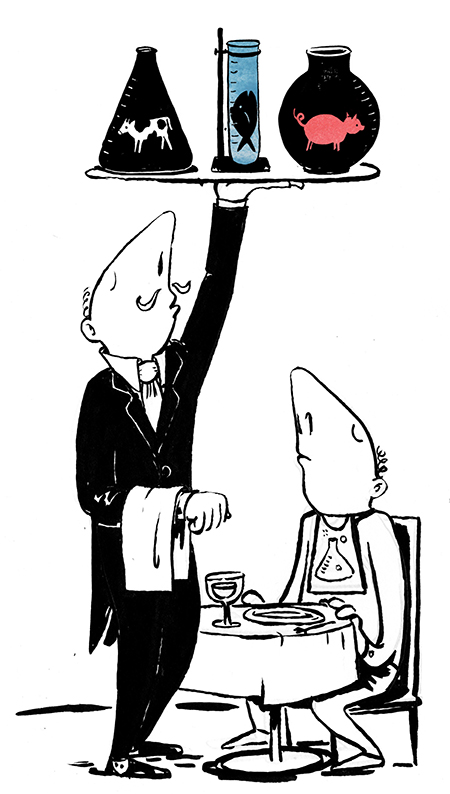ZEITGUIDE TO COFFEE

ZEITGUIDE ‘FOOD’ IMAGE BY KRISTOFER PORTER
Did you know that we are in the midst of the third wave of American Coffee Culture?
The first wave began during the “19th-century surge that put Folgers on every table … the second was the proliferation, starting in the 1960s at Peet’s and moving smartly through the Starbucks grande decaf latte, of espresso drinks and regionally-labeled coffee,” according to Pulitzer Winning Food Critic, Jonathan Gold. The third wave is about beans being “sourced from farms instead of countries, roasting is about bringing out rather than incinerating the unique characteristics of each bean, and the flavor is clean and hard and pure.”
Intelligentsia, Stumptown Roasters, Counter Culture, and Blue Bottle Coffee are the best-known third wave coffee purveyors. At any of those joints, it’s not just about the caffeine: It’s about the exact bean and knowing how it was sourced, obtained, and the terroir of which it came from. It’s about the precise preparation, and the whole coffee-focused experience. Think individual cups created with pour-over brewing devices such as Chemex and Hario V60, high-tech “siphon” coffee, or old school espresso machines.
The vibe is different too. Blue Bottle founder James Freeman puts no power outlets or WiFi in his shops—on purpose. As Businessweek described it, “Blue Bottle’s model is a restaurant: Enjoy your beverage and get out. The relationship Freeman is fostering isn’t between you and your computer or even you and other customers. He wants you to talk to the barista. About coffee.”
And third wave ain’t cheap: up to $80 for a half-pound of rare, roasted beans. More than $3 for cup of pour-over, according to Reuters. And while people are lining up down the sidewalk in downtown Los Angeles to sample the goods from G&B Coffee’s award-winning barista, they’re still a tiny percentage of the coffee-swilling public. Specialty high-end coffee comprises just a small fraction of the $27.9 billion U.S. coffee market.
Some titans of tech are, however, betting on a better brew. The $45.5 million raised for the expansion of Oakland-based Blue Bottle came from such tech entrepreneurs as Tony Conrad of True Ventures (founder of Fitbit and WordPress), Garrett Camp of Uber, Kevin Systrom of Google Ventures (co-founder of Instagram), and Caterina Fake (co-founder of Flickr).
Why? Conrad persuaded his firm to invest in Blue Bottle because he believes third wave coffee is going to be the most lucrative sector of the artisanal food movement. “Everywhere there is a Starbucks, could you put a third wave place across the street? Absolutely,” he says.
ZEITGUIDE friend, Joe Monaghan, president at La Marzocco, which sells and distributes espresso machines, has been watching the bean biz since 1976. He sees coffee finally taking its place among other artisanal foods, and at just the right time. “In American culture, there’s this growing appreciation for food, wine and craft beer,” he told us. “And coffee has come along with that movement.”
Keep Learning,
Brad Grossman
Creator, ZEITGUIDE
Founder, Grossman & Partners
And a quick lesson from ZEITGUIDE friend, John Michael Cassetta on how to make craft coffee at home like a pro barista in just 5 minutes:
Here’s what we’ll need:
- A ceramic pour-over dripper. The cleanest, most elegant brewing solution. Pick one up at your local coffee shop. Bonmac makes a nice one for Blue Bottle that I use every morning.
- A basic kitchen scale. Coffee is all about ratios. Even chefs like me, who eyeball anything under a cup, use a scale for better brewing.
- A grinder. Fresh ground coffee is the key to flavor. Skip the hokey blade versions and pick up a burr grinder. Grinders come in all shapes, sizes and prices, so when in doubt, ask your local barista for suggestions–they’ll steer you in a cost-effective direction.
- Filtered water. Coffee is 95%+ water. East river water in, riverbed coffee out.
- Coffee filters. Purchase filters that fit your dripper. They’re usually sold side-by-side.
- Coffee beans. Last but not least, you want fresh roasted coffee. Check the roasting date on the bag: 3-10 days after roasting is the peak flavor window.
Brewing methodology:
- Put the kettle on. Filtered water, set to boil. Use about twice as much water as your mug size. 3 cups is plenty.
- Measure and grind the beans. We’re looking for ~27 grams for a mug’s worth of coffee. Grind them to the consistency of coarse table salt. Your local coffee shop can even give you a “grind sample” if you’d like.
- Pre-wet the filter. As the water finishes boiling, place your filter in the dripper on top of the mug. Wet the filter with hot water to wash the paper taste off, and to heat your mug. After about 30 seconds, dump the water and pour your ground beans into the wet filter. Shake slightly for an even distribution.
- Brew. Pour about 50g of water onto your grounds, allowing the coffee to “bloom” (you’ll see CO2 bubble up out of the wet grounds, that means it’s fresh). Wait another 30 seconds, then pour another ~350g of water onto the grounds slowly and consistently, over the course of 2-3 minutes, to complete the brewing.
- Drink. Toss the filter, kick back and bask in your accomplishment. Pro-tip: you’ll be able to taste the full flavor profile if you let the coffee cool to lukewarm first.”
Please find all ZEITGUIDE Newsletters here
For more on food culture, get the annual ZEITGUIDE 2014 here.
